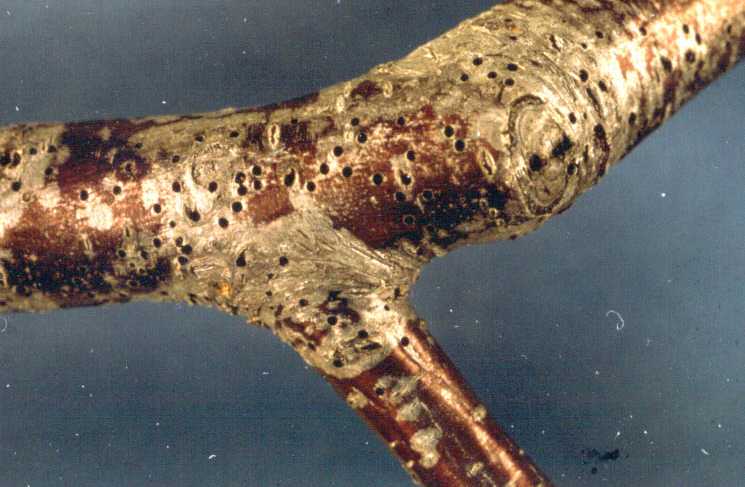Shothole Borer
General Description
Hosts
Fruit trees, native and ornamental hardwood (deciduous) trees; a major pest of stone fruits.
Damage
The shothole borer is attracted not only to diseased, weak or recently dead trees and limbs, but also to apparently healthy trees.
Buds - Small 1.5 mm-wide holes at base of buds can prevent full development of the leaves or blossoms.
Leaves - yellow and wilt due to disruption of sap flow in branches.
Branches and trunk - 1.5 mm-wide holes in the bark, sometimes with white strings of sap hanging from them; tunnels under the bark (Figs. 1, 2, 3).
 |
||
| Figure 1. Exit holes of shothole borer from cherry branch. (AA-FC) | Figure 2. Exposed galleries of shothole borer larvae. (BCMA) | Figure 3. Sap escaping from entry hole. (BCMA) |
Identification
Larva - White, legless, curved, up to 3 mm long.
Adult - 3 mm long, black beetle with reddish legs and antennae (Fig. 4)
| Figure 4. Adult shothole borer. (BCMA) |
Life History
Shothole borers overwinter as mature larvae or pupae in tunnels under tree bark. Adults emerge in May and females fly to susceptible trees where they bore into the cambium and lay their eggs in pockets along the sides of their tunnels. Second generation adults emerge in mid-August
Monitoring
Use yellow sticky board traps (see western cherry fruit fly) to detect adult emergence. Hang a piece of window glass vertically over a pan of soapy water and suspend in or near trees to detect when adults are flying. Check branches for entry holes at the base of buds in May and August; exit holes are randomly scattered along branches.
Management
Cultural Control
Encouraging optimum tree growth and proper orchard sanitation (removing all dead or weak trees and wood) will aid control. Discarded orchard wood, including firewood, is a breeding source for this pest for up to one year. Do not pile wood within orchards because beetles breeding in wood will attack nearby trees. Repeated attacks by heavy populations will kill healthy stone fruit trees. Intercept beetles flying into orchards by placing bundles of three or four 1 to 2 metre-long hardwood tree logs (harvested within the previous year) at 10-20 metre intervals along borders adjacent to wooded areas. Puncture the bark several times to improve release of odours attractive to shothole borers. Destroy the trap logs before the new adults emerge (mid-August).
Chemical Control
No chemical control is available.
